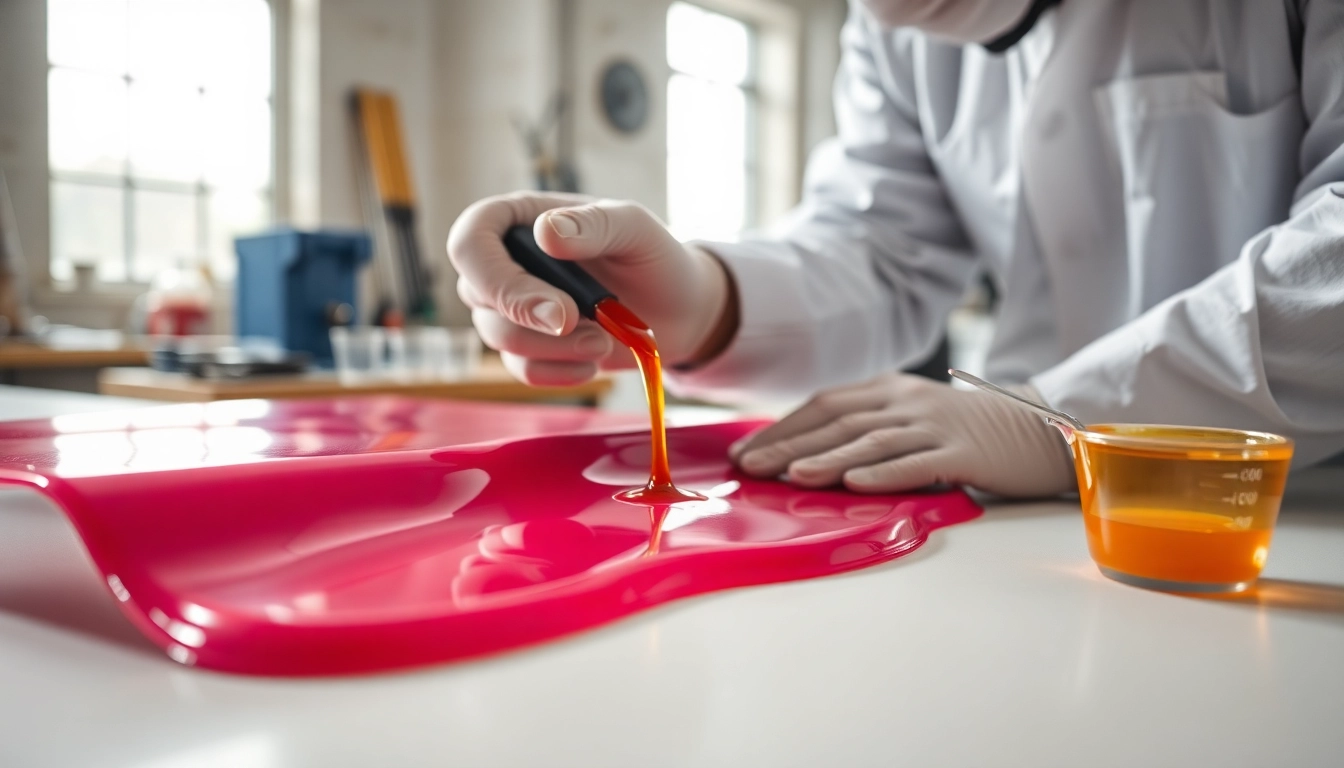Understanding Laminating Resin
What is Laminating Resin?
Laminating resin is a type of synthetic resin predominantly used for bonding layers of materials together, particularly in the realm of fiberglass applications. Its primary role is to serve as a binder that not only holds together layers of composites, such as fiberglass cloth and other reinforcements, but also provides durability and structural integrity to the final product. These resins are available in various formulations, each tailored for specific applications, enhancing their utility in sectors ranging from construction to automotive industries.
When considering laminating resin, it’s essential to understand the distinction between different types. For instance, polyester laminating resins are widely recognized for their cost-effectiveness and ease of use, while epoxy laminating resins are praised for their superior adhesion and mechanical properties. As a result, the choice of resin can significantly influence the performance and longevity of the finished product.
Types of Laminating Resin
Laminating resins can generally be categorized into two main types: polyester resins and epoxy resins. Each type possesses its unique properties, advantages, and potential applications.
- Polyester Laminating Resin: This type is one of the most commonly used in applications such as boat building and automotive parts. It’s known for its quick curing time, reasonable cost, and ease of use. Polyester laminating resin typically requires a catalyst for curing, which initiates the hardening process. It is less adhesive compared to epoxy and can be more prone to shrinking but remains a favorite for many due to its versatility.
- Epoxy Laminating Resin: Offering superior strength and adhesion properties, epoxy laminating resin cures to form a hard and durable bond. It is less prone to shrinkage and provides better water resistance compared to polyester resins. However, it is generally more expensive and may require a longer curing time. Epoxy is often used for high-performance applications where strength and durability are critical.
Common Applications of Laminating Resin
Laminating resin finds use across a broad spectrum of applications. Its primary utility lies in industries where composite materials are prevalent. Some common applications include:
- Marine Industry: Laminating resin is integral to boat construction. It’s utilized to bond fiberglass layers in hulls and decks, providing structural integrity and enhancing the vessel’s resistance to harsh marine environments.
- Aerospace: Epoxy laminating resin is often favored in aerospace applications for its lightweight yet strong properties. It is used to create various components that must withstand aerodynamic forces while minimizing weight.
- Automotive Industry: In automotive manufacturing, laminating resin is used to reinforce components, ensuring they endure the rigors of driving while contributing to overall vehicle performance.
- Construction: Laminating resins are used in the production of composite beams and structural elements, where their strength and lightweight nature can be advantageous.
Benefits of Using Laminating Resin
Durability and Strength
One of the most significant benefits of using laminating resin is its ability to enhance the durability and strength of composite materials. By effectively bonding layers together, it creates a robust structure that can withstand various environmental stresses, including moisture, temperature fluctuations, and mechanical loads. This is particularly critical in sectors such as marine and aerospace, where the integrity and safety of products are paramount.
Versatility in Applications
Laminating resins are versatile and suited for multiple applications. Their adaptability allows manufacturers to use them across various industries, from automotive to consumer goods. This versatility is attributed to the different formulations available, catering to specific requirements such as curing times, environmental resistance, and structural needs. For instance, in the marine industry, different compositions of laminating resin can be applied depending on whether the products are for interior or exterior use, thus extending their utility.
Cost-Effectiveness
When it comes to cost, laminating resins—especially polyester resins—are often more affordable than alternatives such as epoxy resins. Their lower price point makes them appealing for large-scale production where budget constraints are a significant consideration. Furthermore, the faster curing times of many laminating resins can lead to increased production efficiency, ultimately saving both time and costs in manufacturing processes.
Step-by-Step Guide to Applying Laminating Resin
Preparation of Materials
Before applying laminating resin, preparing your materials is crucial for achieving optimal results. The preparation process typically involves the following steps:
- Gather Supplies: Ensure you have all necessary materials at hand, which may include the laminating resin, hardener or catalyst, application tools (such as brushes or rollers), and safety gear (gloves, goggles).
- Surface Preparation: The surfaces to be bonded should be clean, dry, and free of contaminants. Sanding the surfaces lightly can enhance adhesion by providing a better mechanical grip.
- Temperature Control: Check the environmental conditions; ideally, work in temperatures between 70°F to 80°F (21°C to 27°C) to ensure proper curing. Avoid working in high humidity or cold environments, as they can adversely affect the curing process.
Mixing and Application Techniques
Once the surfaces are prepared, the next step is to mix and apply the laminating resin. Follow these guidelines:
- Mixing: Carefully measure the resin and hardener according to the manufacturer’s instructions, ensuring that you achieve the right mixture for effective curing. Use a clean mixing container and stir thoroughly to avoid inconsistencies.
- Application: Using a brush, roller, or spray, apply the mixed resin onto the surface to be bonded. Ensure even coverage, paying special attention to edges and corners to prevent air pockets.
- Layering: If multiple layers are required, follow the curing instructions specific to the resin used. Some formulations allow additional layers to be applied without sanding, while others may require surface preparation between coats.
Post-Application Care
After the application of laminating resin, it’s essential to care for the material to ensure a successful curing process:
- Curing Time: Allow adequate time for the resin to cure, as per the manufacturer’s guidelines. Curing times can vary greatly depending on the specific formulation.
- Temperature Monitoring: Maintain stable environmental conditions during curing to prevent issues such as warping or incomplete hardening.
- Examine the Bond: Once cured, inspect the bond visually for any unexpected issues, such as bubbles or delamination. Address any imperfections adequately before proceeding to finalize the project.
Common Challenges with Laminating Resin
Dealing with Air Bubbles
Air bubbles can often form during the mixing and application of laminating resin, leading to weak spots in the final product. To minimize this issue:
- Ensure that the mixing process is smooth to incorporate minimal air.
- Use a vacuum chamber to degas the resin before application, drawing out any trapped air bubbles.
- Apply the resin in thin layers, allowing for gases to escape before applying additional layers.
Controlling Curing Time
Managing curing times can be tricky, especially if working in fluctuating temperature conditions. Here are some tips to better control the curing process:
- Choose the appropriate hardener based on the ambient conditions to ensure an adequate cure.
- Consider using accelerators if available, particularly when needing quicker curing times in colder environments.
- Regularly monitor the progression of curing, especially in less than ideal situations, and adjust plans as necessary.
Surface Preparation Issues
Improperly prepared surfaces can lead to poor adhesion and structural failure. To ensure proper surface preparation:
- Thoroughly clean the surfaces of any dust, oil, or contaminants using appropriate solvents or cleaning agents.
- Ensure the surfaces are sufficiently roughened through sanding to promote a stronger bond.
- Allow surfaces to dry completely before applying resin; moisture can significantly hinder the bonding process.
Future Trends in Laminating Resin Technology
Eco-Friendly Resin Alternatives
As environmental awareness grows, the demand for eco-friendly laminating resin options is on the rise. Innovations in resin formulations are leading to more sustainable options, including bio-based and recycled resins, which offer similar performance levels without the environmental impact associated with traditional materials. These alternative resins are designed to meet strict regulations in various industries, further aligning product development with sustainability goals.
Innovations in Formulation
Advancements in resin chemistry are enabling the development of new formulations that enhance performance characteristics. These innovations are focused on improving adhesion, lowering viscosity for easier application, and increasing durability against environmental stressors. Furthermore, nanotechnology is being explored to reinforce the properties of laminating resin, providing even greater strength and resilience.
Market Growth Predictions
The laminating resin market is anticipated to experience significant growth, driven by increased demand across sectors such as construction, automotive, and aerospace. As manufacturers continue to seek innovative materials that enhance performance while also adhering to cost-effectiveness, the adoption rate of advanced laminating resins is expected to surge. This growing demand encourages further research and development, paving the way for breakthroughs in formulation and application techniques that will benefit the industry at large.



